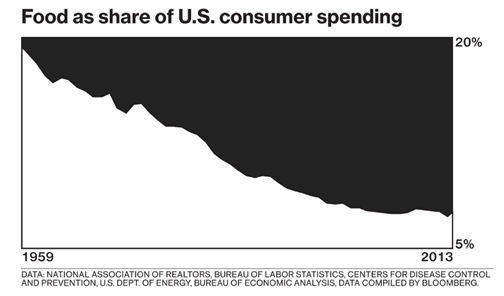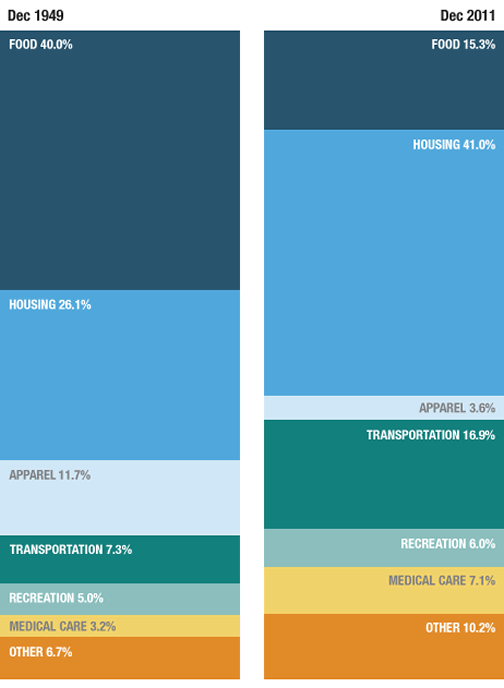Here’s another interesting chart from a Businessweek article about a food-delivery start-up called Blue Apron. It shows how food costs have decreased dramatically as a percentage of total U.S. consumer spending from 1959-2013.

I’ve seen similar stats before, usually to support the argument that food really isn’t that expensive and people can pay for higher-quality, healthier, more wholesome food. (Often by the people selling it.) Does allocating less than 10% of your budget to food mean that you are choosing to eating crap? Looking at this chart in isolation, I can see how you get there, but it isn’t that simple if you look at the bigger picture.
To begin with, improvements in agricultural practices have made many commodities cheaper now than before. At the same time, it appears that food has been squeezed by other “needs” like shelter, transportation, and healthcare which now take up a much larger portion of our budget. Here is a more complete spending breakdown from this NPR article.

Source: Bureau of Labor Statistics, Lam Thuy Vo / NPR
None of this means that you shouldn’t prioritize food quality. Budgeting is all about priorities. Many people live in houses that are bigger than necessary, drive cars that are newer and fancier than necessary, take vacations to exotic locations that would be unheard of in 1959, and so on. It’s just another example that focusing on one little piece of data can be misleading.
 The Best Credit Card Bonus Offers – 2025
The Best Credit Card Bonus Offers – 2025 Big List of Free Stocks from Brokerage Apps
Big List of Free Stocks from Brokerage Apps Best Interest Rates on Cash - 2025
Best Interest Rates on Cash - 2025 Free Credit Scores x 3 + Free Credit Monitoring
Free Credit Scores x 3 + Free Credit Monitoring Best No Fee 0% APR Balance Transfer Offers
Best No Fee 0% APR Balance Transfer Offers Little-Known Cellular Data Plans That Can Save Big Money
Little-Known Cellular Data Plans That Can Save Big Money How To Haggle Your Cable or Direct TV Bill
How To Haggle Your Cable or Direct TV Bill Big List of Free Consumer Data Reports (Credit, Rent, Work)
Big List of Free Consumer Data Reports (Credit, Rent, Work)
Agricultural production, particularly cropping, has also become highly subsidized over that period, which is one in which the Dept of Agriculture moved from a policy of price stability for farmers through controlled supply (think of pouring out milk during the great depression to support prices) to stimulating supply through direct payments to farmers. Not surprisingly, the market price has come down but the full price including the subsidies is probably closer to what it was in 1950 minus gains (albeit significant ones) from increased productivity.
“None of this doesn’t mean that you shouldn’t prioritize food quality.”
Wow. A rare triple negative sighting in the wild.
Can you tell I was an engineering major?
I always liked Elizabeth Warren’s analysis (Two Income Trap) about how the family needs of education (some of which comes out as trying to buy homes in better school districts) and health care spending have gone way up ever since women entered the workforce, where things like clothing spending and food have gone way down. I guess that bar graph could also account for the fact that we are earning more “as a family”, because so many women work.
Agree, it’s the two income thing. Thinking we spend even 10% of our income on food is ludicrous. But we’re a dual income family. And fruits and veggies are cheap in california.
You will soon be considered lucky if you don’t have to decide between buying food and being able to buy our “new and affordable” healthcare.
Only industrialized country still predominately using for profit health insurance. Single payer is the best option but myopic americans by the lies of the medical complex. With half a trillion at stake for big insurance, of course they want their money…
While we are spending less on food we are also getting less from food. It is reasonable to assume that food quality/nutritional value is one factor driving lower percentage spend, but at the same time we are consuming more food than ever before. Consuming more processed food, meaning less fresh foods and ingredients, adds up to less spending. We have all also noticed some package shrinkage but prices staying the same or increasing. Florida’s Natural Growers quietly reduced it’s half gallon orange juice volume from 64 FL.OZ. to 59 FL.OZ. but kept it in the same ‘looks like a half gallon’ container and at the same price or even higher. Tropicana orange juice made the first move on that front several years ago. Food processors pile sugar, which costs next to nothing, into our food and drink. When ordering a pizza, we’re all asked if we want a liter of soda for just another 25 or 50 cents. How else could we purchase and easily drink the equivalent of 1/2 cup or 25 teaspoons of sugar at such a low price? The list goes on and on. We primarily eat high fructose corn syrup, sugar, corn, a little bit of what the package pictures on the front, additives, preservatives, food coloring, added vitamins and salt so we are spending less but eating more with the major tradeoff of less nutritional intake and more calories.
Spending less on food can increase your healthcare costs over time…if you have access to healthcare.
The healthcare reform incentives for adopting Electronic Medical Records(EMR) for physicians practices and hospitals and the insurance exchanges for individuals and employers are both steps in the right direction. However, the reform act cannot achieve it’s true potential while private insurance rules the day with outrageous premiums combined with less coverage – $1100/month plus copays and out of pocket expense to cover a family of four. That costs more than my 1st mortgage including yearly property taxes and insurance. The exchanges, for the first time, provide a tool to locate more affordable plans by offering an apples to apples comparison. However, the plans seem to be offering less coverage with higher deductibles, little to no alternative care coverage, while brand name prescriptions are only covered at 30 – 50% of cost. For example, diabetics taking Lantus have no generic alternative and would have to pay 50% of the monthly cost – which can be upwards of $60 to $70 dollars out of pocket – just for the insulin. Recommend an insurance broker to help explain what it all means because, like the bread aisle in the grocery store, there are many choices with very little differentiation…besides the deductible.
While wading into healthcare reform and the insurance fray, like I just did, can seem hopeless, the best way to reduce health care costs is to increase spending on the right foods and engage in healthy behaviors.
Here are several actions to consider:
1. Spend more on good fresh food. Eat well. You’ll feel better and maybe even want to take a 30 minute walk every day which can reduce the chance of a heart attack by 50% in the older demographics – age 45 and up, or it may incite that cardiac event you so desperately need to change your health behaviors. If you survive that is.
2. Don’t buy that one liter of soda when you order a pizza. You know, I asked my mother when I was born if I could have a half a cup of sugar on a large pepperoni pizza. She just wrapped me in a blanket and put me down for a nap. Just ignore it like my mom or say ‘no thanks’.
3. Buy a couple small juice glasses. Hand squeeze the juice from one large orange to see how much it fills up the glass. That’s all the juice needed at breakfast or any time you have a glass of fruit juice. Purchase 100% juice, not from concentrate as you’re just paying a higher price for mostly water, and only if it comes in a bottle or there are no BPAs in the container, otherwise just eat an apple – Check out whfoods.com. Speaking of apples, Monsanto is proposing a frankenapple that doesn’t turn brown when you cut it. Am sleeping much better knowing we are addressing this major worldwide concern. It’s called the Arctic Apple and can be read about at the Organic Consumers Association.
4. And if you eat beef or chicken, pay more for grass fed beef raised without hormones or antibiotics, and pay more for ‘free-range’ organic chicken. Please note: while free range allows us to imagine a serene pasture somewhere, that may not be the case. Free range can mean chickens that are raised in a cage free area with an opening to the outside. Don’t know if they ever actually go outside. They may just watch 3 hours of TV/day when they’re young increasing to almost 7 hours/day when they’re older and no longer laying eggs…just like us! And when they do put down the remotes and go outside, no one knows if they have access to a range or pasture. Ideally, try to buy your chicken and eggs from local farms that pasture-raise the birds. That means the chickens peck and paw in a field or pasture eating worms, spiders, bugs and slugs, and also eat their feed back at the hen house which is hopefully organic like the packaging says.
When I first set up your budget, start out by adding my fixed, necessary expenses and my savings goals (pay yourself first!). Then see how much I can allocate to variable and discretionary expenses. Food will fall into that category.